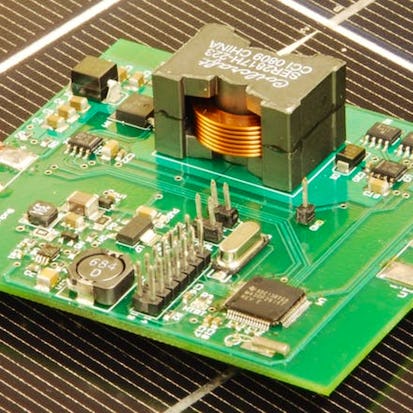- Level Professional
- Duration 17 hours
- Course by University of Colorado Boulder
-
Offered by

About
This course can also be taken for academic credit as ECEA 5703, part of CU Boulder's Master of Science in Electrical Engineering degree. This course covers the analysis and design of magnetic components, including inductors and transformers, used in power electronic converters. The course starts with an introduction to physical principles behind inductors and transformers, including the concepts of inductance, core material saturation, airgap and energy storage in inductors, reluctance and magnetic circuit modeling, transformer equivalent circuits, magnetizing and leakage inductance. Multi-winding transformer models are also developed, including inductance matrix representation, for series and parallel structures. Modeling of losses in magnetic components covers core and winding losses, including skin and proximity effects. Finally, a complete procedure is developed for design optimization of inductors in switched-mode power converters. After completing this course, you will: - Understand the fundamentals of magnetic components, including inductors and transformers - Be able to analyze and model losses in magnetic components, and understand design trade-offs - Know how to design and optimize inductors and transformers for switched-mode power converters This course assumes prior completion of courses 1 and 2: Introduction to Power Electronics, and Converter Circuits.Modules
Introduction to the Course
1
Videos
- A Brief Introduction to the Course
1
Readings
- Course Syllabus
Basic Magnetics: Basic Relationships
1
Videos
- 10.1.1 Basic Relationships
Magnetic Circuits
1
Videos
- Lecture 10.1.2: Magnetic Circuits
Transformer Modeling
1
Videos
- Lecture 10.2: Transformer Modeling
Core and Copper Loss
1
Videos
- 10.3 Loss Mechanisms in Magnetic Devices
Homework Assignment 1: Basic Magnetics
3
Readings
- Study Problems on Basic Magnetics
- Magnetics Design Tables
- Homework Assignment
1
Quiz
- Homework Assignment 1: Basic Magnetics
Introduction to the Skin and Proximity Effects
1
Videos
- 10.4.1 Introduction to the Skin and Proximity Effects
Leakage Flux in Windings
1
Videos
- 10.4.2: Leakage Flux in Windings
Foil Windings and Layers
1
Videos
- 10.4.3: Foil Windings and Layers
Power Loss in a Layer
1
Videos
- 10.4.4 Power Loss in a Layer
Example: Power Loss in a Transformer Winding
1
Videos
- 10.4.5 Example: Power Loss in a Transformer Winding
Interleaving the Windings
1
Videos
- 10.4.6 Interleaving the Windings
PWM Waveform Harmonics
1
Videos
- 10.4.7 PWM Waveform Harmonics
Homework Assignment 2: Skin and Proximity Effects
2
Readings
- Study Problems
- Homework Assignment 2: AC Winding Losses
1
Quiz
- Homework Assignment 2: AC Winding Losses
Several Types of Magnetic Devices
1
Videos
- 10.5 Several Types of Magnetic Devices, their B-H Loops, and Core vs. Copper Loss
Filter Inductor Design Constraints
1
Videos
- 11.1 Filter Inductor Design Constraints
The Kg Method: First-Pass Inductor Design
1
Videos
- 11.2 A First-Pass Design
Multiple Windings: Window Area Allocation
1
Videos
- 11.3.1 Window Area Allocation
Coupled-Inductor Design Constraints
1
Videos
- 11.3.2 Coupled Inductor Design Constraints
First-Pass Design of Multi-Winding Inductors
1
Videos
- 11.3.3 First-Pass Design Procedure: Coupled Inductor
Example: Coupled Inductor for Two-Output Forward Converter
1
Videos
- 11.4.1 Example: Coupled Inductor for a Two-Output Forward Converter
Example: Flyback Transformer
1
Videos
- 11.4.2 Example: CCM Flyback Transformer
Homework Assignment 3: Inductor Design
1
Readings
- Homework Assignment 3: Inductor Design
1
Quiz
- HW3: Inductor Design
Transformer Design: Basic Constraints
1
Videos
- 12.1 Transformer Design: Basic Constraints
First-Pass Transformer Design
1
Videos
- 12.2 First-Pass Transformer Design Procedure
Example: Single-Output Cuk Converter
1
Videos
- 12.3.1 Example: Single-Output Isolated Cuk Converter
Example: Multiple-Output Full-Bridge Buck Converter
1
Videos
- 12.3.2 Example 2: Multiple-Output Full Bridge Buck Converter
AC Inductor Design
1
Videos
- 12.4 AC Inductor Design
Homework Assignment 4: Transformer Design
1
Readings
- Homework Assignment 4: Transformer Design
1
Quiz
- HW4: Transformer Design
Auto Summary
Explore the intricacies of magnetic components essential for power electronic converters with "Magnetics for Power Electronic Converters" by Coursera. Guided by expert instructors from CU Boulder, this professional-level course delves into the design and analysis of inductors and transformers. Spanning 1020 minutes, it covers inductance principles, core material saturation, loss modeling, and optimization techniques. Ideal for those with prior knowledge in power electronics, subscription options include Starter, Professional, and Paid tiers. Enhance your engineering skills and optimize magnetic component design in switched-mode power converters through this comprehensive program.

Dr. Robert Erickson


